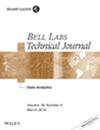下载PDF
{"title":"Optical Ring Metro Networks With Flexible Grid and Distance-Adaptive Optical Coherent Transceivers","authors":"Cristina Rottondi, Massimo Tornatore, Giancarlo Gavioli","doi":"10.1002/bltj.21629","DOIUrl":null,"url":null,"abstract":"<p>The utilization of distance-adaptive coherent optical transceivers in combination with a flexible finer-grained Wavelength Division Multiplexing (WDM) grid has been proposed in optical core networks to enable higher spectral efficiency and flexibility in the allocation of traffic flows. However, the application of distance-adaptive transceivers in metro networks, which are typically based on ring topologies and characterized by shorter distances and lower traffic volumes, is still an open research area both in terms of network resource savings and coherent technology requirements. This paper discusses and analyzes an optical metro ring network architecture with distance-adaptive coherent transceivers and formalizes the routing, modulation level, and spectrum assignment (RMLSA) optimization problem over such a network in order to evaluate the possible benefits introduced by the use of coherent technologies and of a spectrum grid of finer granularity in metro scenarios. Comparisons with legacy WDM systems show significant savings in terms of spectrum occupation and transceiver utilization. © 2013 Alcatel-Lucent.</p>","PeriodicalId":55592,"journal":{"name":"Bell Labs Technical Journal","volume":"18 3","pages":"95-110"},"PeriodicalIF":0.0000,"publicationDate":"2013-11-27","publicationTypes":"Journal Article","fieldsOfStudy":null,"isOpenAccess":false,"openAccessPdf":"https://sci-hub-pdf.com/10.1002/bltj.21629","citationCount":"37","resultStr":null,"platform":"Semanticscholar","paperid":null,"PeriodicalName":"Bell Labs Technical Journal","FirstCategoryId":"1085","ListUrlMain":"https://onlinelibrary.wiley.com/doi/10.1002/bltj.21629","RegionNum":0,"RegionCategory":null,"ArticlePicture":[],"TitleCN":null,"AbstractTextCN":null,"PMCID":null,"EPubDate":"","PubModel":"","JCR":"Q1","JCRName":"Engineering","Score":null,"Total":0}
引用次数: 37
引用
批量引用
Abstract
The utilization of distance-adaptive coherent optical transceivers in combination with a flexible finer-grained Wavelength Division Multiplexing (WDM) grid has been proposed in optical core networks to enable higher spectral efficiency and flexibility in the allocation of traffic flows. However, the application of distance-adaptive transceivers in metro networks, which are typically based on ring topologies and characterized by shorter distances and lower traffic volumes, is still an open research area both in terms of network resource savings and coherent technology requirements. This paper discusses and analyzes an optical metro ring network architecture with distance-adaptive coherent transceivers and formalizes the routing, modulation level, and spectrum assignment (RMLSA) optimization problem over such a network in order to evaluate the possible benefits introduced by the use of coherent technologies and of a spectrum grid of finer granularity in metro scenarios. Comparisons with legacy WDM systems show significant savings in terms of spectrum occupation and transceiver utilization. © 2013 Alcatel-Lucent.
具有柔性网格和距离自适应光相干收发器的光环城域网络
提出了在光核心网中使用距离自适应相干光收发器与灵活的细粒度波分复用(WDM)网格相结合的方法,以提高频谱效率和业务流分配的灵活性。然而,距离自适应收发器在城域网络中的应用,无论是从节约网络资源还是对相关技术的要求来看,仍然是一个开放的研究领域,城域网络通常基于环形拓扑结构,具有距离较短、业务量较小的特点。本文讨论和分析了具有距离自适应相干收发器的光城域环网体系结构,并形式化了这种网络上的路由、调制级别和频谱分配(RMLSA)优化问题,以便评估在城域场景中使用相干技术和更细粒度的频谱网格所带来的可能好处。与传统WDM系统相比,在频谱占用和收发器利用率方面节省了大量资金。©2013阿尔卡特朗讯
本文章由计算机程序翻译,如有差异,请以英文原文为准。

 求助内容:
求助内容: 应助结果提醒方式:
应助结果提醒方式:


